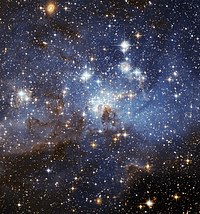
Photo from wikipedia
We use a series of magnetohydrodynamic simulations including both radiative and protostellar outflow feedback to study environmental variation of the initial mass function (IMF). The simulations represent a carefully-controlled experiment… Click to show full abstract
We use a series of magnetohydrodynamic simulations including both radiative and protostellar outflow feedback to study environmental variation of the initial mass function (IMF). The simulations represent a carefully-controlled experiment whereby we keep all dimensionless parameters of the flow constant except for those related to feedback. We show that radiation feedback suppresses the formation of lower mass objects more effectively as the surface density increases, but this only partially compensates for the decreasing Jeans mass in denser environments. Similarly, we find that protostellar outflows are more effective at suppressing the formation of massive stars in higher surface density environments. The combined effect of these two trends is towards an IMF with a lower characteristic mass and a narrower overall mass range in high surface density environments. We discuss the implications for these findings for the interpretation of observational evidence of IMF variation in early type galaxies.
Journal Title: Monthly notices of the Royal Astronomical Society
Year Published: 2022
Link to full text (if available)
Share on Social Media: Sign Up to like & get
recommendations!